- Hire employees in India using an Employer of Record (1-2 days setup, handles compliance) or establish a legal entity (2-3 months) for direct control over larger teams.
- How to hire employees in India requires proper worker classification, compliant employment contracts, background verification, and complete onboarding documentation.
- Mandatory costs and compliance include Provident Fund (12%), Employee State Insurance (3.75%), gratuity, monthly tax deductions, and adherence to four labor codes plus state employment laws.
- Cultural considerations include hierarchical work culture, proper employee vs contractor classification, and managing time zone differences for effective communication.
Ready to build your team in India? Reach out to us today!
Discover how we create impactful content.
Thinking about hiring employees in India? You’re not alone, many global companies find the process daunting with all the unique legal, cultural, and compliance details to consider. That’s why we’ve put together this guide to make things easier. We’ll walk you through every step of hiring in India, from understanding employment laws and tax rules to mastering onboarding and building your team the right way. Whether you’re just starting out or looking to grow your presence, this article will help you navigate the hiring process in India with confidence and clarity.
How to hire employees in India?[toc=How to Hire in India]
Drawing from our extensive experience supporting global companies, we’ve found that successfully hiring employees in India requires a clear understanding of local regulations, payroll practices, and workplace culture.
1. Hiring Employees
- Choose your hiring method: set up a legal entity or use an Employer of Record (EOR) for faster onboarding.
- Clearly define job roles and draft detailed employment contracts outlining compensation, benefits, and compliance with Indian labor laws.
- Collect necessary documents (PAN, bank details, offer letter) and register employees with statutory bodies like the Provident Fund and Employee State Insurance.
2. Paying Employees
- Structure salaries as Cost to Company (CTC), including basic pay, allowances, and statutory benefits such as Provident Fund and health insurance.
- Process payroll in Indian Rupees, deduct applicable taxes (TDS), and ensure timely statutory filings each month.
- Maintain compliance with minimum wage laws and provide payslips as per regulations.
3. Managing Employees
- Onboard employees with clear orientation and support for a smooth start.
- Foster engagement through regular feedback, recognition, and professional development opportunities.
- Adapt management practices to local work culture, respecting hierarchy and communication styles.
Following these steps ensures compliance, builds trust, and helps companies establish effective teams in India.
What are the hiring options in India?[toc=Hiring Options]
When you want to hire employees in India, there are two main options: setting up your own entity or partnering with an Employer of Record (EOR). Based on our experience helping companies enter the Indian market, both have distinct benefits depending on your business needs.
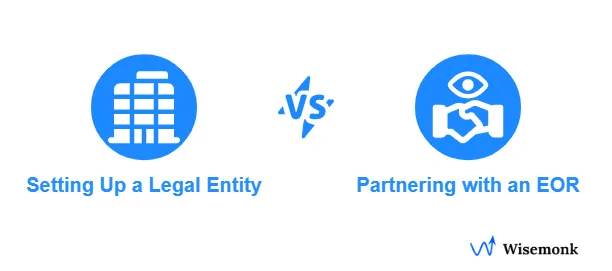
Option 1: Setting Up a Legal Entity
This is suitable for long-term plans or large teams. It gives you full control over payroll and compliance but requires registering with Indian authorities, opening a bank account, and following tax and labor laws, including statutory benefits like provident fund and health insurance. While it takes time and effort, it lets you directly manage your workforce.
Option 2: Partnering with an Employer of Record (EOR)
If you need a faster, simpler solution, an EOR can be ideal. The EOR legally employs your team, handling contracts, payroll, taxes, and compliance. This is perfect for testing the market or hiring a small team without setting up a legal entity. We’ve seen many companies benefit from this approach to avoid administrative burdens and focus on growth.
Based on our extensive experience guiding global businesses, here is a detailed comparison table to help you understand the differences between setting up a legal entity and using an Employer of Record (EOR), so you can choose the right hiring solution for your business:
If you are unsure about which hiring options would be best for your business, check out our article on "Employer of Record vs Own Entity: Choose the Right Global Hiring Strategy".
How to classify Indian workers: Employees or Contractors?[toc=Employees vs Contractors]
Once you’ve decided how you want to hire, whether by setting up an entity or partnering with an EOR, the next step is understanding how to classify workers correctly as either employees or independent contractors. Based on our experience managing teams across India, we can confirm that misclassifying workers can lead to serious penalties under Indian labor laws, and no employer wants that!
Let’s break down both classifications so you can make informed decisions:
- Employees: Work under formal contracts, receive statutory benefits (paid leave, provident fund, health insurance), and are managed by the employer. They follow company policies and are usually exclusive, long-term team members.
- Independent Contractors: Self-employed, engaged for specific projects or short-term work. They don’t get employee benefits, control how and when they work, and often use their own resources. Contractors can work for multiple clients and are paid per project or milestone.
If you still unsure which one would be good for you, check out our artilce: "Remote Hiring in India: Independent Contractor vs EOR Employee Explained"
How to send job offers & employment letters to employees in India?[toc=Offer Letters]
Once you’ve found the right candidate for your role in India, the next step is formalizing the hire by sending a job offer letter and an employment letter. These documents are essential for setting clear expectations and ensuring compliance with Indian labor laws.
.avif)
Drawing on our experience supporting global employers, we’ve found that sending clear, compliant job offer and employment letters is essential for a smooth hiring process in India.
Step 1: Job Offer Letter
The job offer letter is the first document sent to your selected candidate. It outlines key details like job title, salary (CTC), benefits, start date, and work location. While not legally binding, it sets clear expectations and helps avoid misunderstandings. Including a salary breakdown and specifying the offer expiry date are best practices.
Step 2: Employment Letter
Once the candidate accepts the offer, an employment (or appointment) letter is issued. This legally binding document details terms of employment, compliance clauses, probation period, termination policies, and confidentiality agreements. It formalizes the relationship and ensures alignment with Indian labor laws.
How can we simplify this process for you?
When you partner with us as your EOR, we take care of everything, from drafting compliant documents to ensuring they align with Indian employment laws. Here’s how it works:
- You send a personalized job offer letter to your selected candidate.
- After acceptance, we prepare a compliant employment letter tailored to Indian regulations.
- The candidate reviews and signs both documents digitally.
- Onboarding begins once all paperwork is complete.
Wisemonk assists clients in drafting legally compliant offer letters that are in line with Indian labor laws and best practices. to reflect any changes in regulations or industry standards.
What are the key elements of a job offer letter in India?
To ensure clarity and professionalism, include these elements in your job offer letter:
- Job Title & Role Description: Clearly state the position and key responsibilities.
- Compensation Details: Mention annual CTC (Cost to Company) and provide a salary breakdown if possible.
- Benefits & Perks: Highlight health insurance, leave policies, bonuses, or other perks.
- Start Date & Location: Specify when and where the employee will begin work.
- Acceptance Instructions: Provide clear steps for signing and returning the letter.
Having helped numerous global employers send job offers and employment letters in India, we can confidently say that clarity and compliance are key. A well-drafted offer sets clear expectations for both parties while ensuring legal protection for your business.
How to create an employment contract for employees in India?[toc=Employment Contract]
In our experience drafting employment contracts for global clients, a clear, compliant agreement is vital for protecting both your business and your employees in India. Here’s how to keep it straightforward and effective:
- Job Title and Responsibilities: Clearly define the employee’s role, duties, and expected outcomes. Include a clause allowing reasonable changes to responsibilities based on business needs.
- Compensation and Benefits: Outline the salary structure, including base pay, allowances, and bonuses. Specify how and when salaries will be paid (e.g., monthly via bank transfer). Mention benefits like health insurance or provident fund contributions.
- Working Hours and Leave Policies: State standard working hours, overtime provisions, and leave entitlements (e.g., annual leave, sick leave, maternity/paternity leave). Include public holidays and compensatory off policies if applicable.
- Confidentiality and Non-Compete Clauses: Add clauses to protect your company’s confidential information. Ensure non-compete terms are reasonable in scope and duration to comply with Indian law.
- Termination Conditions: Specify notice periods for both employer and employee. Include terms for termination due to misconduct or poor performance, along with severance pay details if applicable.
Types of Employment Contracts in India
- Permanent Contracts: For long-term roles with full benefits.
- Fixed-Term Contracts: For project-based or seasonal work with a defined end date.
- Probationary Contracts: Typically for 3–6 months to evaluate suitability before permanent employment.
- Part-Time Contracts: For reduced working hours with pro-rated benefits.
- Consultant Agreements: For independent contractors; ensure they are clearly differentiated from employee contracts to avoid misclassification risks.
Drafting employment contracts in India requires compliance with labor laws such as the Industrial Employment (Standing Orders) Act, 1946, and state-specific Shops and Establishments Acts. By keeping contracts detailed yet straightforward, you can avoid legal risks while ensuring transparency with your employees!
How to onboard a remote employee in India?[toc=Onboarding Checklist]

Having worked extensively with global companies hiring in India, we can confidently say that onboarding a remote employee is one of the most critical steps in building a successful remote team in India, It works best with a structured, people-focused approach. A seamless process not only helps new hires feel welcomed but also drives engagement and retention.
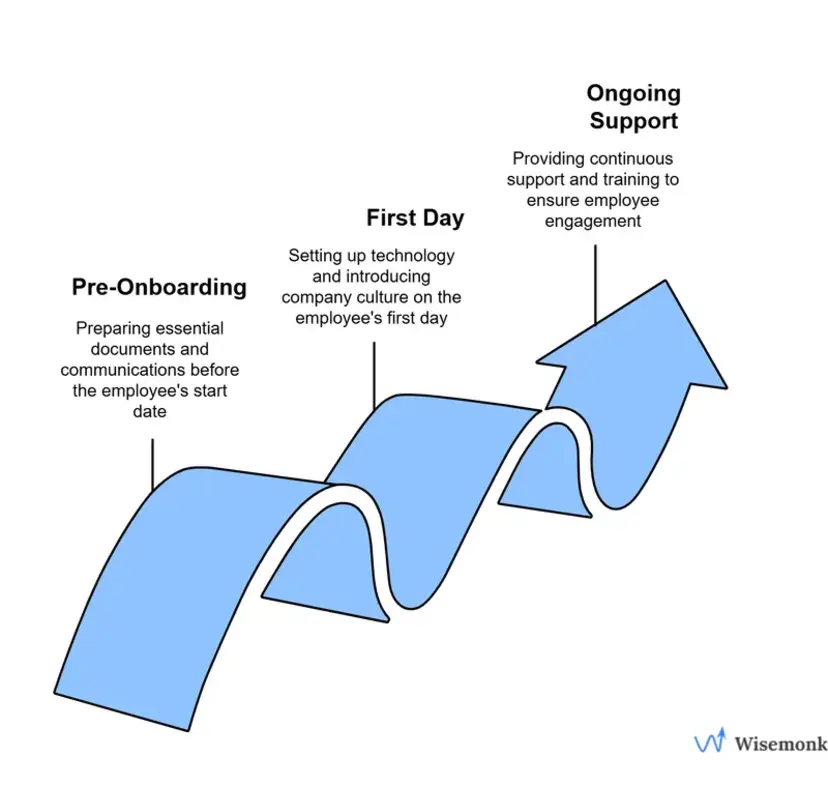
Step 1: Pre-Onboarding Preparation
- Collect essential employee information and documents (ID proof, bank details, certificates).
- Draft employment contracts—if using an Employer of Record (EOR), they handle this for you, ensuring compliance.
- Complete background verification with the candidate’s consent.
- Send a warm welcome email or package to introduce the company and team.
Step 2: First Day Setup
- Ensure all employment documentation (contracts, NDAs, tax forms) is signed and filed.
- Provide access to necessary tools, software, and communication platforms.
- Schedule a virtual orientation to introduce company culture, values, and policies.
- Arrange virtual meet-and-greets with team members for early connections.
Step 3: Ongoing Support and Engagement
- Schedule regular check-ins (weekly or bi-weekly) to discuss progress and address questions.
- Offer training sessions on job roles and company tools.
- Ensure HR support is accessible for payroll, benefits, or compliance queries.
- Collect feedback on the onboarding experience to refine your process.
Are Non-Disclosure Agreements (NDAs) legally enforceable in India?[toc=NDAs]
Protecting sensitive business information is crucial when hiring employees in India, and Non-Disclosure Agreements (NDAs) are a key tool for safeguarding your intellectual property and trade secrets. As your Employer of Record (EOR), we can confirm that NDAs are legally enforceable in India, provided they are carefully drafted and meet the requirements of Indian law.
Let’s break this down so you can understand how NDAs work in India and what makes them enforceable.
What makes NDAs enforceable under Indian Laws?
NDAs are governed by the Indian Contract Act, 1872, which outlines the general criteria for any valid contract. For an NDA to be enforceable, it must:
- Clearly define what constitutes confidential information.
- Have reasonable restrictions in terms of scope and duration.
- Include consideration (exchange of value) between the parties.
- Be signed by all involved parties with free consent.
However, Section 27 of the Indian Contract Act prohibits agreements that unreasonably restrain a person’s ability to practice their lawful profession, trade, or business. NDAs that impose fair and reasonable restrictions, such as protecting trade secrets, are generally upheld by Indian courts.
How to run background checks on Indian Employees?[toc=Background Checks]
Hiring employees in a new country can be challenging, and running background checks is an important step in India due to the prevalence of resume fraud. As an Employer of Record (EOR) in India, we’ve helped global employers conduct background checks efficiently and in compliance with Indian laws.
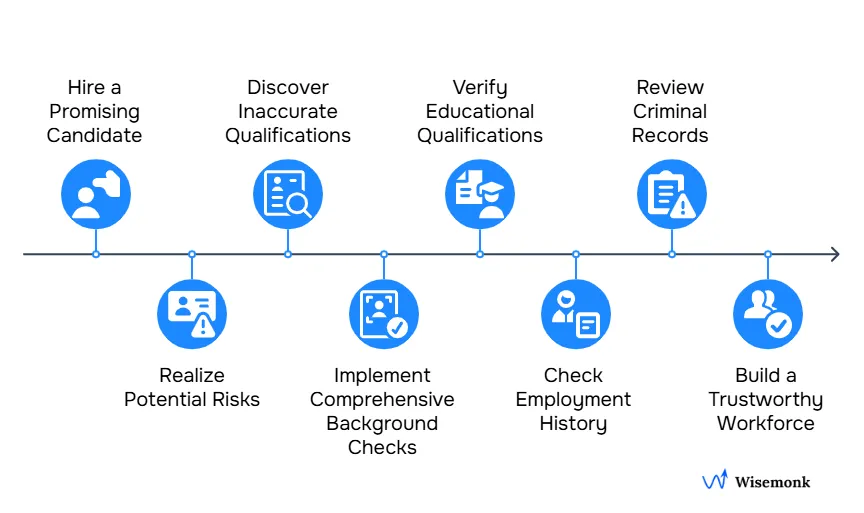
While background checks aren’t legally required, employers can request information relevant to the job role, such as criminal history or education verification.
What should you include in background checks for employees in India?
- Criminal Record Check
- Employment History
- Reference Check
- Work Authorization
- Education History
- Credit Reports (Optional)
- Social Media Profiles (Optional)
These checks help ensure you hire trustworthy employees and maintain compliance with local regulations. For more details on how to run background checks step by step, check out our article: Employee Background Checks in India for 2025.
How to manage payroll and taxes for employees in India?[toc=Payroll & Taxes]
Managing payroll and taxes in India requires a structured approach to ensure accuracy and compliance. Here’s a concise, step-by-step guide based on best practices and regulatory requirements:
1. Register for TAN:
Obtain a Tax Deduction and Collection Account Number (TAN) from the Income Tax Department to legally deduct and remit taxes from employee salaries.
2. Collect Employee Details:
Gather all necessary information, including PAN, bank details, and investment declarations, for accurate payroll processing and statutory compliance.
3. Calculate Gross Salary:
Determine the employee’s gross salary by adding basic pay, allowances (like HRA, transport), and bonuses.
4. Apply Deductions:
Deduct statutory contributions and taxes:
- Employee Provident Fund (EPF): 12% of basic salary
- Employee State Insurance (ESI): For eligible employees (up to ₹21,000/month)
- Professional Tax: As per state regulations
- Income Tax (TDS): Based on income tax slabs and investment declarations
5. Calculate Net Pay
Subtract all deductions from the gross salary to arrive at the net pay, which is credited to the employee’s account.
6. Remit Taxes and Contributions
Deposit TDS by the 7th of the following month, and ensure timely payments of PF, ESI, and professional tax as per statutory deadlines.
7. Issue Payslips and Maintain Records
Provide detailed payslips to employees and maintain accurate payroll records for compliance and audits.
For more details about pay stub, check out our article: Pay Stub in India: What Foreign Employers Need to Know
For more detailed information on payroll processing in India, check out our article: Payroll in India: A Comprehensive Guide.
If you’re considering outsourcing payroll tasks, explore our article: Top 10 Payroll Outsourcing Companies in India.
What are the mandatory employee benefits in India?[toc=Employee Benefits]
When hiring employees in India, employers are required to provide certain mandatory benefits as per employment laws in India. These benefits ensure employee welfare and compliance with regulations. Let’s break down the key mandatory employee benefits you need to know.
Employee Provident Fund (EPF):
The Employee Provident Fund (EPF) is a mandatory retirement savings scheme where both employee and employer contribute 12% of the employee’s basic salary each month. Of the employer’s share, 3.67% goes to EPF and 8.33% to the Employee Pension Scheme (EPS). EPF ensures long-term financial security and provides tax benefits for employees in India.
Employee State Insurance (ESI)
ESI is a health insurance program for employees earning up to ₹21,000 per month. Employers contribute 3.75% of the salary, while employees contribute 0.75%. It covers medical expenses, maternity benefits, and disability compensation.
Gratuity
Gratuity is a lump sum payment made to employees who have completed at least five years of continuous service. It is calculated as:
Gratuity = (Last drawn salary × 15 × years of service) ÷ 26
For more details, you can explore "Online Gratuity Calculator 2025: Calculate Your Payments with Ease".
Maternity Benefits
Under the Maternity Benefit Act, female employees are entitled to 26 weeks of paid maternity leave for the birth of their first two children, along with medical bonuses.
Leave Entitlements
Employees are entitled to paid leaves such as:
- Casual Leave: For personal reasons, typically 7–10 days annually.
- Sick Leave: For health-related issues, usually 12 days annually.
- Earned Leave: Accumulated leave based on days worked, often around 15–30 days annually.
Bonus Payments
Under the Payment of Bonus Act, employers must pay a bonus to eligible employees earning up to ₹21,000 per month. The bonus ranges from 8.33% to 20% of their annual salary.
Minimum Wage Compliance
Employers must adhere to state-specific minimum wage laws that vary by industry and skill level.
Providing these mandatory benefits not only ensures compliance but also builds trust with your workforce. For more details on employee benefits in India, check out our article: Employee Benefits in India: A Complete Guide.
What are the employment laws in India?[toc=Employment Laws]
In our experience guiding employers in India, understanding employment laws is crucial for compliance and smooth operations. India’s legal framework protects employee rights and regulates workplace relationships through both central and state-specific laws.
Central Labor Codes
India has consolidated its many labor laws into four major labor codes:
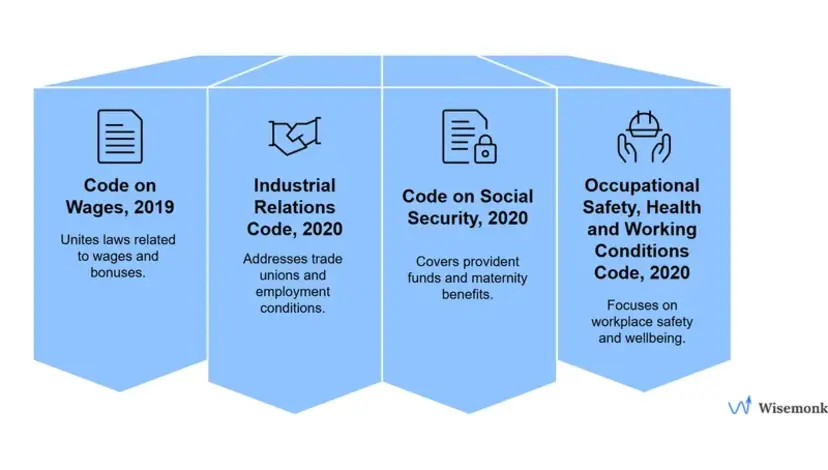
Code on Wages (2019):
- Regulates minimum wages and payment schedules.
- Ensures equal pay for equal work regardless of gender.
- Combines existing laws like the Minimum Wages Act and Payment of Wages Act.
Code on Social Security (2020):
- Expands social security benefits to include gig and platform workers.
- Consolidates laws like the Employees’ Provident Fund Act and Employees’ State Insurance Act.
Industrial Relations Code (2020):
- Simplifies dispute resolution procedures for strikes, layoffs, and retrenchments.
- Introduces a re-skilling fund for workers who lose their jobs.
Occupational Safety, Health, and Working Conditions Code (2020):
- Sets standards for workplace safety, health, and welfare facilities like clean drinking water and restrooms.
- Reduces compliance paperwork by merging multiple laws.
State-Specific Employment Laws
While the labor codes provide a unified framework, state-specific laws still play a significant role in regulating employment terms like working hours, leave policies, and wages. For example:
- Shops and Establishments Acts: Each state has its own version of this Act governing work hours, holidays, leave entitlements, and employment conditions for commercial establishments.
- Industrial Relations Acts: States like Maharashtra have additional provisions for resolving disputes under their Industrial Relations Acts.
Non-compliance with Indian employment laws can lead to penalties or legal disputes. Adhering to these regulations ensures fair treatment of employees and protects your business from reputational and financial risks.
For more detailed insights into India’s employment laws, check out our article: Employment Laws in India: What Employers Must Know in 2025.
How to protect the company’s Intellectual Property (IP) in India?[toc=IP Protection]
Protecting your intellectual property in India is essential for securing your business assets and maintaining a competitive edge. In our experience guiding companies through the Indian market, registering your IP under Indian law is the most effective first step.
Register Your IP in India
The first step is registering your intellectual property under Indian laws. Without registration, enforcing your rights becomes difficult. Here’s what you can register:
- Patents: Protect inventions and innovations under the Patents Act, 1970.
- Trademarks: Secure your brand name, logo, or slogan under the Trademarks Act, 1999.
- Copyrights: Safeguard creative works like software, designs, and written content under the Copyright Act, 1957.
- Designs: Protect unique product designs under the Designs Act, 2000.
Registration gives you legal ownership and makes it easier to act against infringement.
Monitor for Infringements
Once registered, keep an eye on the market for unauthorized use of your IP. This could include counterfeit products, copied designs, or misuse of your brand name. Regular monitoring helps you act quickly if someone violates your rights.
Enforce Your Rights
If you discover infringement, take immediate action. In India, you can:
- File a civil lawsuit for damages or injunctions to stop further misuse.
- Use specialized IP courts for faster resolution of disputes.
Acting promptly shows that you’re serious about protecting your IP and discourages others from infringing.
Leverage International Treaties
India is part of global treaties like the TRIPS Agreement and Madrid Protocol. These treaties allow foreign companies to extend their IP protection across multiple countries through a single application. If you’ve already registered your IP elsewhere, this makes protecting it in India easier.
Work With Local Experts
India’s IP laws can be complex and navigating them requires expertise. Partner with experienced local IP attorneys who understand the nuances of Indian regulations and can guide you through registrations and enforcement.
What is the work culture like in India?[toc=Work Culture]
Imagine a scenario where a US-based manager expects direct, immediate feedback, but their Indian team member provides a more indirect, context-driven response. Or consider a situation where a European team member leaves the office at 5 PM sharp, while their Indian counterpart stays late to demonstrate commitment and team spirit.
These differences highlight how Indian work culture is shaped by unique values and practices. Let’s explore the key aspects of Indian work culture in simple terms.
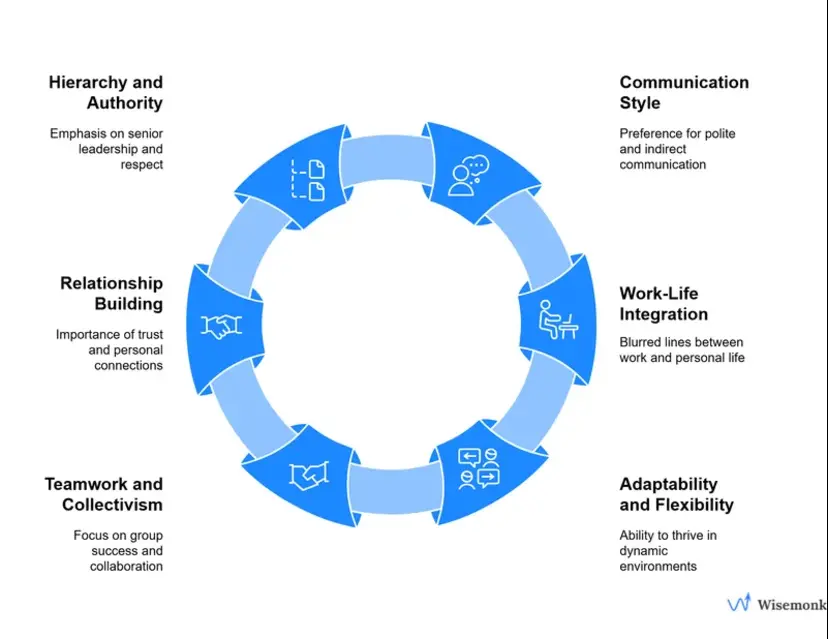
- Hierarchy and Respect for Authority: Indian workplaces are hierarchical, with decisions often coming from senior leaders who are highly respected.
- Relationship Building: Trust and personal connections matter deeply, and relationships often extend beyond the workplace.
- Teamwork and Collectivism: Employees prioritize group success over individual achievements, emphasizing collaboration and harmony.
- Communication Style: Communication tends to be polite and indirect, avoiding confrontation to maintain respect and harmony.
- Work-Life Integration: The lines between work and personal life are often blurred, with employees staying late or participating in team activities outside work hours.
- Adaptability and Flexibility: Indian professionals are highly adaptable, thriving in dynamic environments and adjusting quickly to changes.
For a deeper dive into this topic, check out our article: Work Culture in India: All You Need to Know.
How do you handle employee termination in India?[toc=Terminations]
Terminating employees in India requires adherence to specific legal frameworks to ensure fairness and compliance. Whether it’s due to redundancy, misconduct, or poor performance, the process must be handled carefully to avoid disputes and penalties. Let’s break it down step by step.
Here are the important laws and guidelines you should be aware of:
- Shops and Establishments Act governs termination notice periods and valid reasons for dismissal, such as redundancy or misconduct.
- Termination terms, including notice periods and severance pay, are often outlined in the employment contract.
- For redundancies, employees are entitled to retrenchment compensation (15 days’ pay for every completed year of service).
- Employers must pay outstanding wages, bonuses, accrued leave, and severance within two days of termination as per the Payment of Wages Act.
Our HR experts have identified four main types of termination in India:
Notice Periods and Compensation
- Notice periods typically range from 30–90 days based on the employee’s role and contract terms.
- Severance pay is mandatory in cases of retrenchment or layoffs and is calculated as 15 days’ average pay for each year of service.
Steps for Handling Termination
- Provide Written Notice: Issue a formal termination letter stating the reason for dismissal.
- Conduct Investigations (if needed): For misconduct cases, conduct a fair inquiry before making a decision.
- Settle Final Dues: Pay all pending wages, leave encashments, bonuses, and severance within two working days post-termination.
- Recover Company Property: Ensure laptops, ID cards, or other assets are returned during the exit process.
What are the common compliance challenges employers face in India?[toc=Compliance Challenges]
In our experience working with global companies, navigating compliance in India can be complex due to its layered laws and regulations. Here are the most common challenges:

- Misclassification of Employees: One of the biggest pitfalls is incorrectly classifying employees as contractors or consultants. This can lead to non-compliance with labor laws and tax regulations.
- Payroll and Tax Errors: Mistakes in calculating wages, deductions, or contributions can result in fines and penalties—something no employer wants to deal with!
- Inadequate Documentation: Not maintaining proper records like employment contracts, payroll details, or statutory documents can lead to legal disputes or compliance issues.
- Non-Compliance with State-Specific Laws: India’s state-specific laws vary widely, and failing to meet these requirements can result in penalties or liabilities.
The consequences of non-compliance can be serious—fines, imprisonment, or even reputational damage. That’s why it’s essential to take compliance seriously and seek professional guidance to ensure you’re adhering to all applicable laws and regulations.
Why choose Wisemonk to hire employees in India?[toc=How Wisemonk helps]
Wisemonk is a specialized Employer of Record (EOR) in India, built for global companies looking to hire, pay, and manage employees in India without the complexities of setting up a local entity. We provide end-to-end workforce solutions tailored to India’s regulatory landscape, ensuring seamless compliance, payroll, and dedicated HR support for your offshore teams.
Here’s how Wisemonk supports your hiring needs:
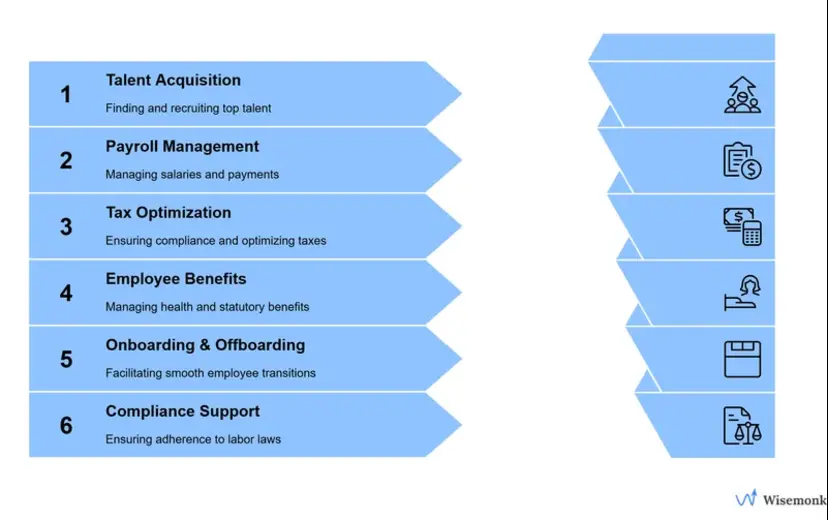
- Talent Acquisition: We help you find top talent in India quickly and efficiently.
- Payroll Management: From salary calculations to timely payments, we handle it all.
- Tax Optimization: We ensure compliance with Indian tax laws while optimizing deductions.
- Employee Benefits: We manage health insurance, provident fund, and other statutory benefits.
- Onboarding & Offboarding: Seamless processes for welcoming and transitioning employees.
- Background Checks: Thorough pre-employment screenings to ensure you hire the right people.
- Equipment Procurement: We handle device sourcing, setup, and delivery for remote employees.
- Compliance Support: Full adherence to Indian labor laws and regulations to avoid penalties.
- Offshore Team Setup: Need a GCC or offshore team? We provide end-to-end support, including company registration.
Beyond these core services, we provide advanced support in contractor management, company registration, and work permit & visa assistance. Our services is designed to streamline every aspect of hiring and managing employees in India, so you can focus on growing your business while we handle the complexities.
Ready to build your team? Let’s get started!
FAQs
How can I legally hire an employee in India?
To legally hire an employee in India, you have three primary options: using an Employer of Record (EOR) like Wisemonk, setting up a local legal entity, or engaging contractors. The EOR method is the fastest and most compliant approach, allowing you to onboard employees within 1-2 weeks while ensuring full adherence to Indian labor laws and regulations.
How much does it cost to hire an employee in India?
The cost of hiring an employee in India varies depending on the role and location, but typically ranges from $1,500 to $3,500 per month, including salary, statutory contributions, and administrative costs. An EOR service like Wisemonk can help manage these costs effectively, with pricing starting around $99 per employee per month, significantly reducing overhead compared to traditional hiring methods.
How to pay employees in India?
You can pay employees in India through local payroll in Indian Rupees, ensuring all statutory deductions like Provident Fund and taxes are made. Many companies use an Employer of Record (EOR) or payroll provider to handle payments and compliance.
How do I hire someone in India?
You can hire in India by setting up a local entity or partnering with an Employer of Record (EOR), which manages contracts, payroll, and compliance so you can onboard employees quickly and legally.
Can a US company hire an employee in India?
Yes, US companies can hire employees in India through several methods. The most straightforward approach is partnering with an Employer of Record (EOR) like Wisemonk, which handles all legal, payroll, and compliance requirements. This method allows US companies to quickly and compliantly build a team in India without establishing a local legal entity.
Can a US employee work in India?
US employees can work in India by obtaining the appropriate work visa, typically an Employment Visa (E-Visa) or Business Visa (B-Visa). The visa process requires sponsorship from an Indian company, documentation of qualifications, and compliance with immigration regulations. Companies like Wisemonk can assist in navigating the complex visa and work permit processes.
How do US companies pay Indian employees?
US companies can pay Indian employees through several methods: using an Employer of Record service that handles local payroll, setting up a local bank account, or using international payroll platforms. Wisemonk specializes in managing payroll for international companies, ensuring compliance with Indian tax laws, statutory contributions, and seamless salary disbursement.
What is the minimum wage in India in US dollars?
The minimum wage in India varies by state and industry but generally ranges from $90 to $250 per month. In major metropolitan areas and for skilled positions, the minimum monthly wage can be higher, typically around $300 to $500. However, actual salaries depend on factors like job role, experience, and industry standards.







.png)
%201.png)